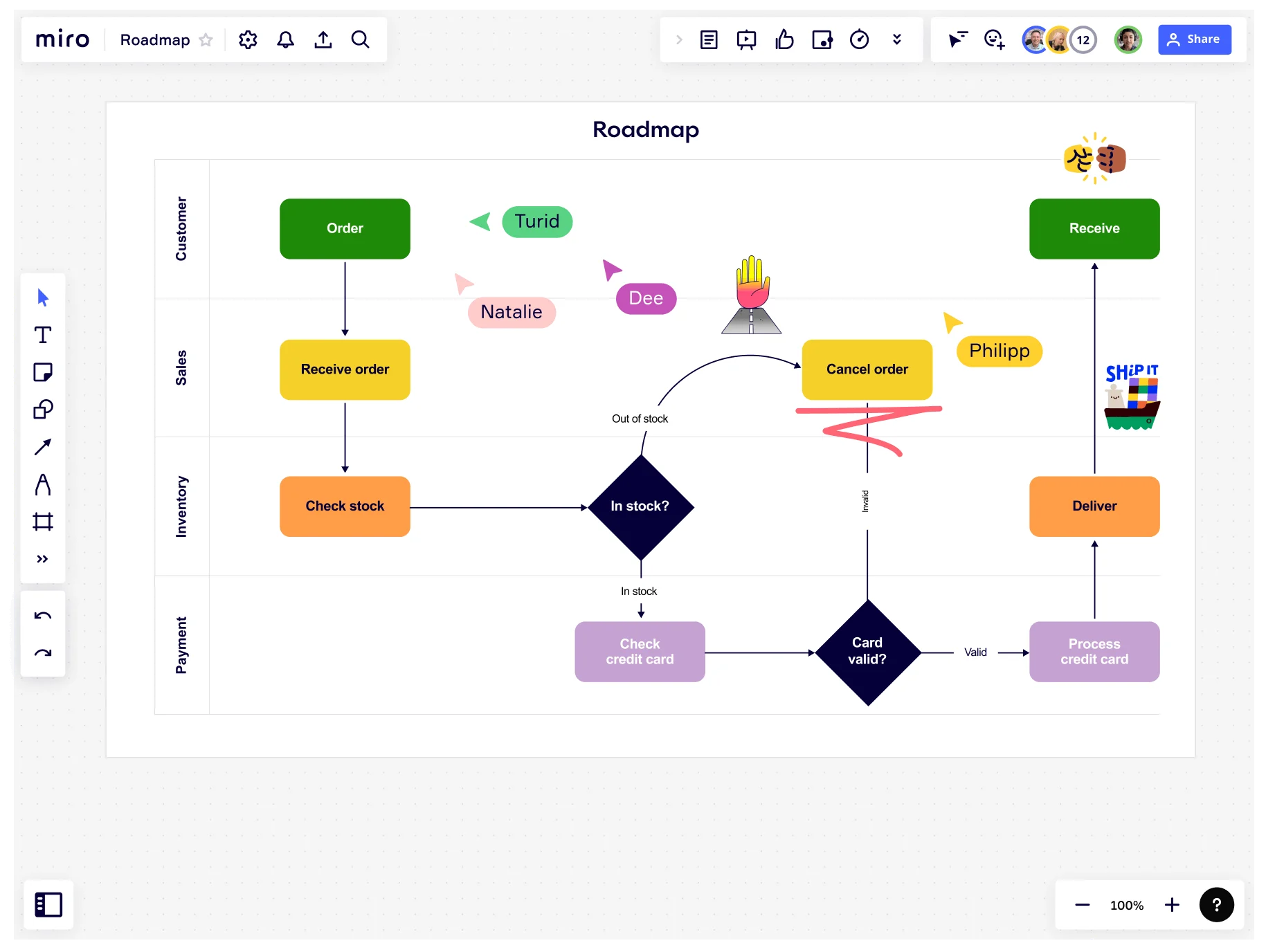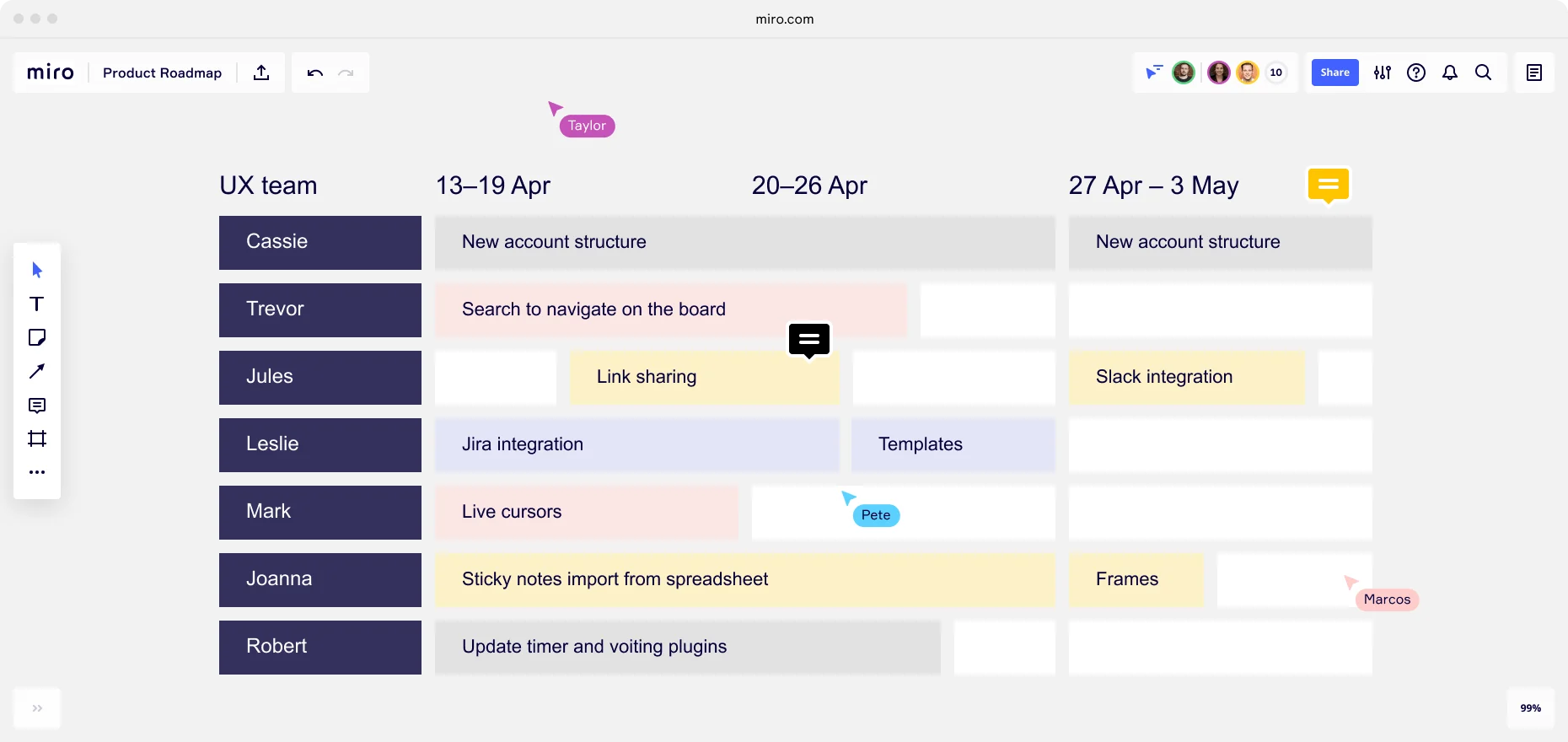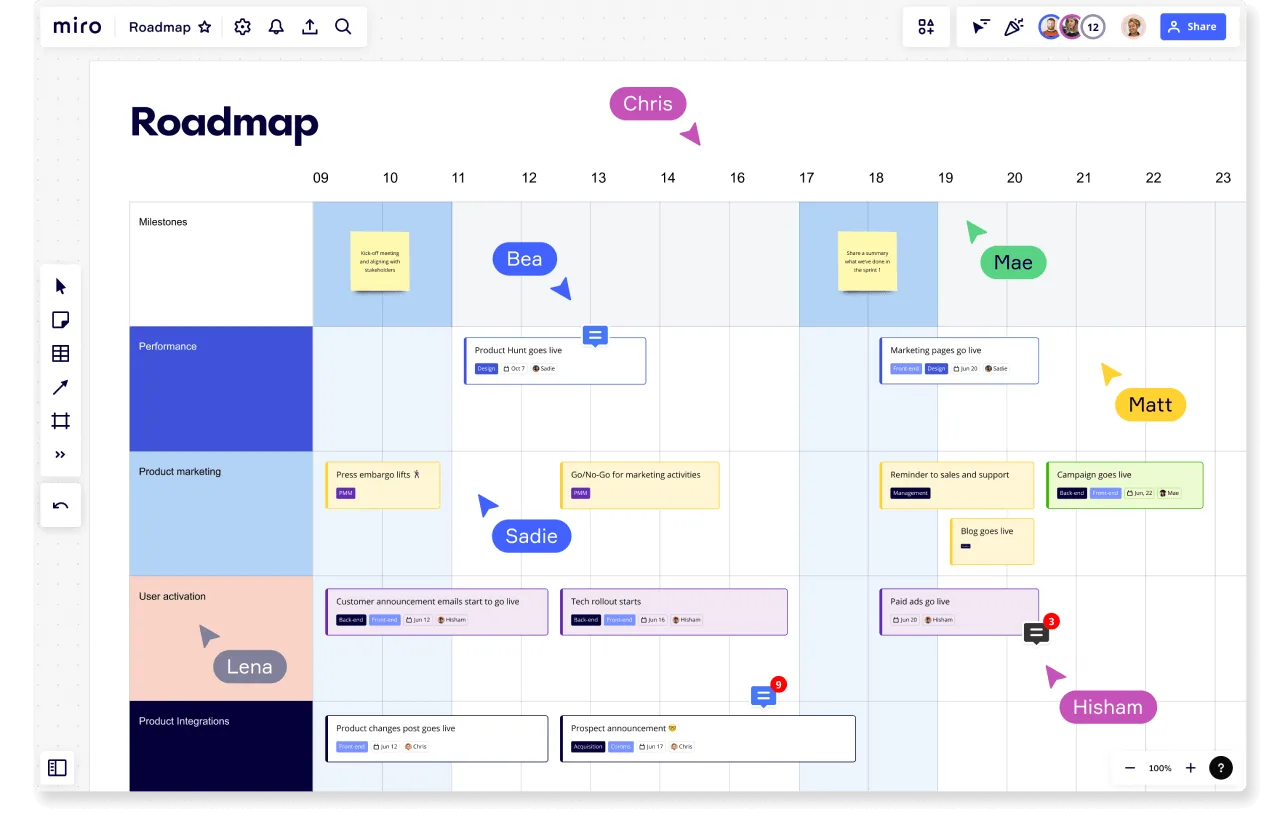
Table of contents
Table of contents
What is a roadmap?

What is a roadmap?
A roadmap is your team’s source of truth — it keeps them productive and on track. Cross-functional teams can use a visual roadmap to communicate goals and work in sync to achieve them. Whether developing a product or implementing a marketing strategy, creating a roadmap is critical for your project.
At its core, a roadmap is a visual representation of a strategy. It shows the goals that a team is working towards and how they are going to achieve them. Roadmaps give a more tangible aspect to a strategy. As the name implies, it’s a map your team can refer to throughout a project. If the ideas and concepts in a strategic plan are abstract, it can be difficult to implement the strategy. A roadmap allows teams to visualize the steps when they implement a strategic plan and to better understand the outcomes. It bridges the gap between a strategy’s design and execution. A roadmap also serves as a great communication tool for team members. These documents outline team members’ responsibilities and how each person fits into the larger strategy giving all stakeholders a high-level overview of the strategic plan.

Benefits of creating a roadmap
Here are some advantages of developing a roadmap for your projects:
Provides a high-level overview
Understanding a multi-facetted project from the outset can be difficult for teams. Many of the effective processes may be abstract, and explaining them without some sort of communicative tool can be difficult. A roadmap is a tool to capture all of the necessary stages of a project in one guide.
Preempt problems and blockers
Not all projects sail smoothly — unexpected obstacles can crop up anytime. A roadmap helps your team identify these roadblocks before the strategy implementation begins. This prepares your team with the skills to overcome obstacles quickly and efficiently. This aspect of a roadmap prevents delays and budgeting disasters.
Helps with resource management
A roadmap can help managers understand how much time and manpower is needed for each project stage ensuring that the right resources are always available. This maximizes time efficiency and minimizes waste.
Helps cross-functional collaboration and visualize dependencies
Projects often require multiple teams in a business to operate in sync. One team’s processes may rely on another teams’ action. For example, a software engineering team should only begin development once the account manager has received confirmation from the client. Visualizing these cross-team dependencies helps the strategy stay on track and reduces bottlenecks.

Creates accountability and keeps team members on track
A roadmap is a fantastic communication tool for visually depicting each team member’s role in the project. This keeps team members accountable, as they can appreciate the importance of their work in the greater scheme of things. Referring to the roadmap can also help identify where a process is breaking down and who is involved at that stage. Being able to pinpoint accountability encourages team members to speak up. If anyone feels off course, they can ask for help.
Helps with time management
A detailed, time-oriented roadmap can prevent scope creep, a common reason for delayed projects. By recording the project goals from the start, all stakeholders know the project's boundaries. Team leads can communicate the expected project timeframe and individuals can better manage their time.
Types of roadmaps
Different roadmaps serve different purposes, depending on the strategic goal. Let’s take a look at some common types of roadmaps:
Product roadmap
A product roadmap outlines the direction, priorities, progress, and long-term vision of your company’s product. It outlines the plan of action to achieve product-related goals and how this will add value to your business. Building a roadmap for each product will help your business prioritize the products with greater value. Products generating the greatest profits become the primary focus. As a result, time and resources are channeled in the right direction.

This product roadmap template shows how a collaborative, shared roadmap can display which team owns which projects. Each team defines the tasks, projects, and initiatives that need to be completed and assigns who the point person will be. This document is also a good example of how to visualize information using emojis and colors when building your product roadmap.
Technology roadmap
A technology roadmap is a visual document outlining a plan for technology adoption within a company. This could be anything from accounting software to new manufacturing technology replacing manually operated machines. The technology roadmap templates are ideal for leaders and people in management roles. It helps them strategize how their companies will evolve with changes in technology. These roadmaps are useful for resource management and long-term planning.
Marketing roadmap
This type of roadmap is all-encompassing as it outlines your marketing strategy and the long-term goals of this master plan. Visualization of strategic marketing initiatives helps teams allocate the right resources to a marketing strategy. It also guides decisions on what advertising techniques to use to ensure your campaigns reach your target audience.
Business roadmap
A business roadmap is a high-level document outlining the overall progress and vision of a company. It helps different departments understand how their functions fit into the greater business strategy. Business roadmaps are usually based on long-term strategic goals. This forward-thinking approach helps leaders identify potential risks and roadblocks. These are excellent roadmaps for new and startup businesses as they help define a clear mission and culture.
Agile roadmap
You can use an Agile roadmap template for any type of project, but they are commonly used for product development. This is because Agile roadmaps are flexible instead of rigid. They can change throughout the product development process according to the product vision and business needs. This type of roadmap enables Agile teams to break down the overarching goals into themes called “epics” helping with goal setting and backlog prioritization.

Miro's product roadmap templates are great to start your planning process, helping you visualize your product's journey and align your team on key initiatives.
Best practices for creating a roadmap
Creating an effective roadmap requires a clear understanding of your goals, the resources you have available, and the time frame in which you need to complete your project. Keep these tips in mind when developing your roadmap:
Communicate the ‘why’
One of the main objectives of a roadmap is to capture and document an overall vision. This is especially useful for a new business lacking in direction. Understanding the reason for a strategy is just as important as implementing it. Team members need to know why they are doing something, as this gives them purpose and direction. A roadmap reminds team members that their actions benefit the company’s overall vision.
Keep it simple
Don’t include too many details in your roadmap, or you risk it becoming too complicated to comprehend. It should be a high-level representation of your strategy. Use visuals and colors to communicate ideas instead of words to prevent your roadmap from being text-heavy.
Share with the relevant people
Road maps communicate the vision and progress of a project, but only if everyone involved has access to the document. When sharing the document, invite your team to make comments and ask questions. This encourages collaboration and sets clear expectations.
Make it adaptable
It’s natural for a strategy or vision to change, but it’s important to reflect these changes on your roadmap. Changes to your strategy may include shifting dates, pushing back on deliverables, or reallocating responsibilities. Ensure that your roadmaps are agile and adaptable so that you can easily update them. Referring to an inaccurate, out-of-date roadmap could derail your project.
Don’t overpromise
It may be tempting to set lofty goals when creating your road map, especially if you want to impress your clients. But for the roadmap to be useful, it needs to be practical. Make sure your timeframes are realistic and your milestones achievable. Ask your team for feedback on what they can realistically produce in a timeframe. Take their capabilities into account and the resources you have at your disposal for the projects. Map these achievable goals on your roadmap so you don’t set overly high expectations.
Tips for creating a roadmap
Follow these steps to create a concise, easy-to-understand roadmap.
1. Choose the right type of roadmap
Begin by identifying the strategy or process that you plan on outlining. This should help you to choose the right type of roadmap for your needs, and the right road mapping tool to build one. Use one of these roadmap templates to help you make this decision.

2. Define your strategy
Think about the overall strategy you want your roadmap to show. Here is a list of questions to ask yourself when defining your strategy:
What is the end goal of this process?
Who are the different role players?
What are the biggest challenges the company is facing?
Who is your target customer?
Where does the company want to go?
How is the organization going to grow?
How could we improve the product we offer?
3. Identify the highest-value initiatives
Break down the process or strategy into different outcomes and initiatives, then prioritize to decide which of these is most important for achieving your strategic goals. The Fibonacci scale template is a great tool for deciding priorities before adding them to your roadmap. This method helps you estimate the effort and risk attached to each task.
4. Establish milestones and deadlines
Mark points on your roadmap where there should be a certain outcome or achievement. Time-specific milestones break down the strategy into achievable goals and concrete actions. They also help teams measure progress and track whether the project is on track.
5. Clarify teams and stakeholders
Clearly outline all project stakeholders, both internal and external. Miro’s tagging tool is a great way to ensure everyone knows their strategic roles and how they fit into the roadmap.
6. Decide on the timeline
A project can’t go on forever, so your roadmap requires an end date or a timeline. Setting a timeframe creates accountability and keeps the project on track. Be realistic when you set the timeline.
7. Share your roadmap and collaborate
Be sure to make the roadmap accessible to everyone on your team. Gather stakeholder input by sharing it with external parties that are involved. This builds transparency and builds a shared understanding of the strategic goals. Invite your team to make suggestions to improve the roadmap and make it more useful.
8. Bring your roadmap to life
Roadmaps shouldn’t be static and stale but rather living, breathing documents. Incorporate colors, tag your team members, and add new milestones that bring value to your roadmap.